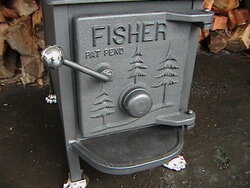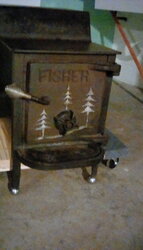Dated manuals, brochures and items such as posters and advertisements give an idea of the improvements through the years. Many pictures in ads were very old pictures of stoves so you can't go by the pictures used on dated pages. Old parts were used up, but the stove building pace was so fast it didn't take long. There are no exact dates of changes since fabricators could buy parts from Fisher, make their own or buy locally. The only thing they couldn't supply themselves were doors. The foundries that cast them would only know the foundry marks and as time went on foundries across the country were used to prevent shipping doors all from the west coast.
There was a huge amount of boxes containing receipts and paperwork in Bob's basement where the first stove made was stored. That paperwork would show when stainless springs were no longer available (if the manufacturer changed the stock number of the new style) and such things as the increase of their own 5 fin draft caps being sold compared to Baxter's........ Some changes are shown on the original drawings such as shields and upper brick courses. Just because they constantly sent revised prints to fabricators doesn't mean they had to make the changes.
PA stoves were numbered before serial numbers, so a confidential customer list shows who bought what model with the stove number and sale date.
It took me a long time to figure out where the XL came from just by comparing each one that showed up and where they were advertised. A sort of reverse history which is subject to change with new information.
So yes, you could cut the handle short on a later door, replace the new style spring handle with old, (not too many have a collection of the old springs or knobs) and change the draft cap from 5 to 4 fin to make it look like an earlier stove. Normally chrome ball handles and pipe cap dampers were on the older doors without trees, so there's a limit how far back to change things. There is always a possibility that old parts were scrounged to get a stove out the door when currently used parts ran out.
There is always the exception;

Older Pat Pend door with cap and ball from an earlier time period showing this is probably a transition stove from old door to new... (Newer feet added since it would have had chrome ball feet)
There are many archived news articles that give information of new products and I've used ads stating "New Fireplace Insert now available" or ads selling only the original 5 models to figure out when new models were introduced. Again reverse history going back in newspaper dates until you find the first advertisement of a new model.
Trademarks give "first day of use in commerce" and patent dates on parts give a close idea of when changes were made. Of course parts could be in use long before they were patented. So we only know what came before what, not when.
 This baby bear followed me home after I saw it on my local Craigslist. I heat my home with a papa bear but always wanted to have a baby bear for hunting cabin to be built in the future. Any body have a factory build date based on the serial numbers? This one is stamped DBB 2316 On the back. I'm assuming it's a Dunn Brothers since I live in West Virginia.
This baby bear followed me home after I saw it on my local Craigslist. I heat my home with a papa bear but always wanted to have a baby bear for hunting cabin to be built in the future. Any body have a factory build date based on the serial numbers? This one is stamped DBB 2316 On the back. I'm assuming it's a Dunn Brothers since I live in West Virginia.

